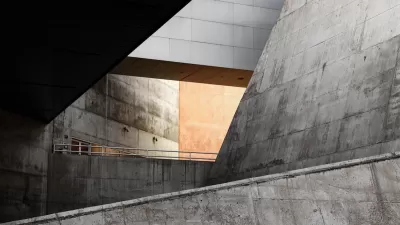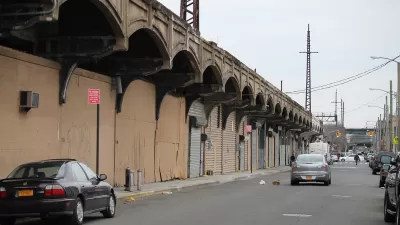After 5 decades of abandonment, and recent inspiration from the much-lauded High Line, a rusty railway stretching three-and-a-half miles through central Queens may become NYC’s next elevated greenway.
Lisa W. Foderaro reports: “'QueensWay' [is being reconceived as a] would-be linear park for walkers and bicyclists in an area desperate for more parkland and, with the potential for art installations, performances and adjacent restaurants, a draw for tourists interested in sampling the famously diverse borough.” Many feel the project is long overdue and supporters like Will Rogers, president and chief executive officer of the Trust for Public Land, say that “[i]t’s Queens’s turn” to soak in some of New York City's limelight.
Though potential obstacles include fund raising challenges, Foderaro highlights progress already made: "the trust has already raised tens of thousands of dollars for the project, in addition to the state grant [that will fund a community planning survey and feasibility study].” She also vets the land trust's capacity, adding that “it has broad experience in fostering linear parks, having worked on four dozen such parks, mostly on ground level, around the country," including the Bloomingdale Trail, an elevated railway to park conversion in Chicago.
Many apparently stand to benefit from the development. “About 250,000 residents live within a mile of the proposed park, and its backers see all kinds of ancillary benefits, from health to traffic,” says Foderaro.
QueensWay differentiates itself from the High Line in several ways. For one, the city already owns the land in question, and will not need to acquire it, as it did with the High Line. Also, the project does not call for the reconstruction of “a steel structure... requir[ing] nothing more than the clearing of tracks, the selective removal of trees and the pouring of asphalt” in some places. QueensWay will also welcome bicycles, now prohibited on the High Line. Finally, QueensWay is being promoted as a ‘cultural trail’ that "will be defined by the neighborhoods it passes through” in contrast to the High Line, which re-defined its surrounding neighborhoods.
FULL STORY: In Queens, Taking the High Line as a Model

What ‘The Brutalist’ Teaches Us About Modern Cities
How architecture and urban landscapes reflect the trauma and dysfunction of the post-war experience.

‘Complete Streets’ Webpage Deleted in Federal Purge
Basic resources and information on building bike lanes and sidewalks, formerly housed on the government’s Complete Streets website, are now gone.

The VW Bus is Back — Now as an Electric Minivan
Volkswagen’s ID. Buzz reimagines its iconic Bus as a fully electric minivan, blending retro design with modern technology, a 231-mile range, and practical versatility to offer a stylish yet functional EV for the future.

Healing Through Parks: Altadena’s Path to Recovery After the Eaton Fire
In the wake of the Eaton Fire, Altadena is uniting to restore Loma Alta Park, creating a renewed space for recreation, community gathering, and resilience.

San Diego to Rescind Multi-Unit ADU Rule
The city wants to close a loophole that allowed developers to build apartment buildings on single-family lots as ADUs.

Electric Vehicles for All? Study Finds Disparities in Access and Incentives
A new UCLA study finds that while California has made progress in electric vehicle adoption, disadvantaged communities remain underserved in EV incentives, ownership, and charging access, requiring targeted policy changes to advance equity.
Urban Design for Planners 1: Software Tools
This six-course series explores essential urban design concepts using open source software and equips planners with the tools they need to participate fully in the urban design process.
Planning for Universal Design
Learn the tools for implementing Universal Design in planning regulations.
City of Albany
UCLA Lewis Center for Regional Policy Studies
Mpact (formerly Rail~Volution)
Chaddick Institute at DePaul University
City of Piedmont, CA
Great Falls Development Authority, Inc.
HUDs Office of Policy Development and Research



























